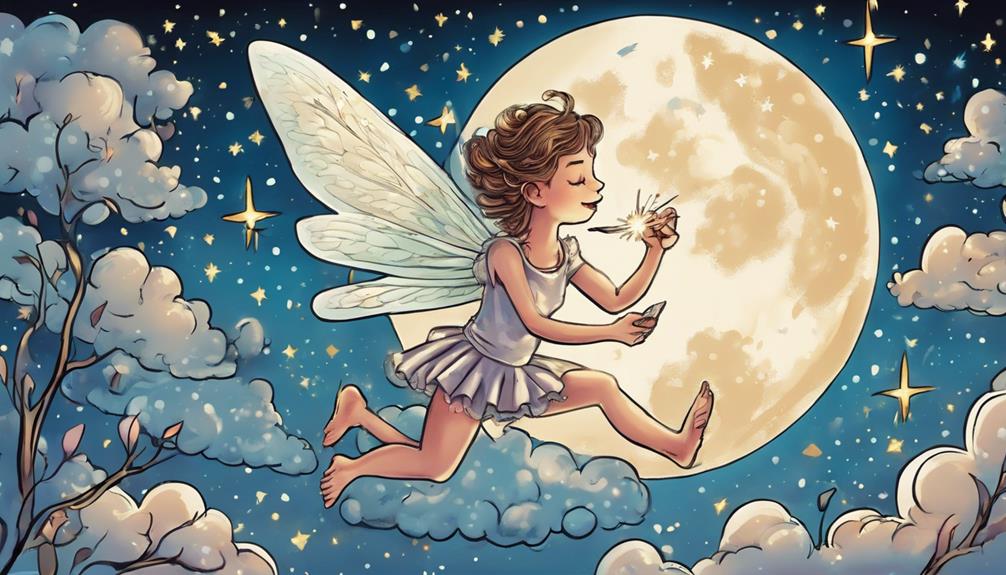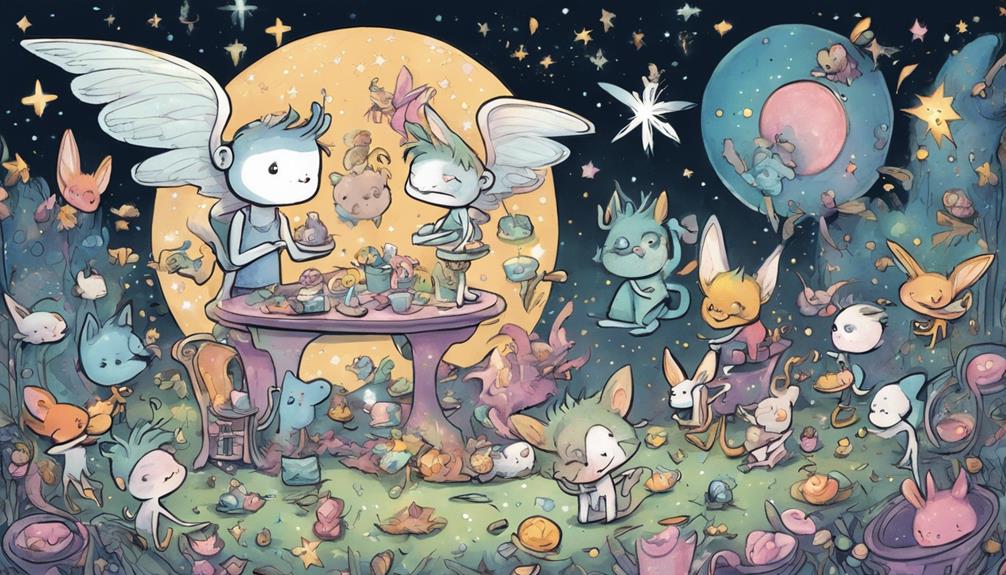The Tooth Fairy faces numerous challenges that can make her job difficult. You're not alone if you've noticed the rising payouts due to inflation, with the average first lost tooth costing around $5.84 in 2024. Many parents struggle to balance the magic of the fairy with honest discussions about money, especially as children's skepticism grows around ages 7 to 8. Plus, cultural variations introduce different practices that can complicate her mission. With so much at stake, maintaining belief while maneuvering these shifting dynamics is essential. Discover more about the Tooth Fairy's journey through these trials and tribulations ahead.
Key Takeaways
- Economic disparities affect the Tooth Fairy tradition, with varying experiences based on families' financial situations and increasing payout expectations.
- Maintaining the magic of the Tooth Fairy is challenging as children's skepticism grows, often influenced by technology and social media.
- Parents struggle to balance the excitement of the myth with honesty, preferring transparency while wanting to preserve childhood wonder.
- Cultural variations in tooth loss celebrations highlight the Tooth Fairy's adaptability but also complicate maintaining a consistent tradition globally.
Evolution of the Tooth Fairy Myth

The Tooth Fairy myth has evolved considerably from its origins in 10th-century Northern Europe, reflecting changing cultural beliefs and practices surrounding childhood and tooth loss.
Initially, parents collected lost teeth for protection and blessings, connecting to burial customs and superstitions. As the myth spread, it transformed into the Tooth Fairy tradition that's recognized today, where children place their lost teeth under their pillows, waiting for a magical exchange.
In the early 20th century, especially during the 1950s, the American adaptation gained popularity, coinciding with a prosperous era that introduced cash rewards for lost teeth. This shift not only made the tradition more exciting for kids but also expanded the practice to include compensation for every lost tooth, rather than just the first. By 2024, the average payment for a lost tooth reached $5.84 in the U.S.
Cultural variations, like Ratoncito Pérez in Spanish-speaking countries and La Petite Souris in France, showcase diverse folklore surrounding tooth loss rituals. These adaptations highlight how different societies interpret the significance of lost teeth, reflecting their unique beliefs about childhood, growth, and luck.
Balancing Magic and Honesty

You might find it tough to balance the magic of the Tooth Fairy with the need for honesty as your child grows.
As they start questioning these childhood beliefs, you face a dilemma about how much truth to share.
Steering through this change can strengthen your bond while keeping the enchantment alive.
Navigating Childhood Beliefs
How can parents balance the enchanting world of the Tooth Fairy with the inevitable arrival of honesty as their children grow and begin to question such beliefs?
This delicate dance often starts around ages 7 to 8 when kids begin to scrutinize the stories they've cherished. You want to nurture their creativity, but you also need to address their curiosity about the truth behind the Tooth Fairy.
As your child loses their last tooth, it's a prime opportunity to create cherished memories while encouraging open dialogue. Talk about how the tradition fosters joy and wonder, enhancing their imaginative play. You can share your own nostalgic experiences, which can strengthen emotional connections and make the conversation feel more personal.
Instead of presenting the Tooth Fairy as a strict reality, frame her as a symbol of childhood magic. This allows you to embrace their questions while maintaining the spirit of the tradition.
The goal isn't to extinguish their belief but to guide them towards a more nuanced understanding of the world—a blend of imagination and honesty that prepares them for future adventures.
Parents' Dilemma of Truth
Many parents often grapple with the challenge of balancing the enchanting allure of the Tooth Fairy with the need for honesty as their children begin to question these beloved myths. This parents' dilemma of truth becomes especially pronounced around ages 7-8, when curiosity peaks and the magic of childhood starts to fade.
While some parents embrace transparency, opting for open discussions about the Tooth Fairy, others find themselves torn between maintaining tradition and fostering trust. Revealing the truth about the Tooth Fairy can carry emotional weight for children, marking a painful shift from innocence to a more adult understanding of reality.
You might worry about how to navigate your child's curiosity while keeping the enchantment alive. Finding the right moment to disclose the truth can be confusing, and there's no one-size-fits-all answer.
However, acknowledging the magic of the Tooth Fairy while explaining reality can deepen family bonds. These discussions encourage emotional connections and spark conversations about belief and imagination, allowing you to guide your child through this delicate phase with love and understanding.
Balancing magic and honesty ultimately enriches both your relationship and your child's growth.
Economic Challenges of Tradition

Steering through the economic challenges of the Tooth Fairy tradition has become increasingly complex for parents, who face rising costs and varied expectations.
As a parent, you may find yourself juggling expectations while managing your budget. Here are some key factors influencing the tradition's economics:
- The average payout for a first lost tooth has risen to $5.84 in 2024, reflecting inflation.
- Economic disparities mean parents in lower socio-economic statuses often give less, affecting children's experiences.
- Over 56% of parents admit to forgetting to leave money under pillows, illustrating the pressures of maintaining the tradition.
- Societal trends push parents to increase payouts, especially for that first lost tooth, complicating financial decisions.
As you navigate these challenges, the balance between fostering a sense of magic and teaching your child about financial values becomes essential.
When your child loses that lower tooth, you might feel compelled to match peer expectations, even if it strains your budget.
Adapting to these economic realities while keeping the tradition alive is no small feat, but it's part of the adventure of parenthood.
Cultural Adaptations and Variations

When you look at how different cultures handle the tooth exchange ritual, you'll see a fascinating variety of practices.
From Spain's Ratoncito Pérez to Japan's unique tooth-throwing customs, each tradition has its own twist.
These global adaptations highlight how deeply personal and culturally significant the act of losing a tooth can be.
Global Tooth Exchange Practices
Cultural adaptations around tooth exchange practices reveal fascinating variations, from Spain's Ratoncito Pérez to Japan's tradition of tossing teeth onto roofs for good luck. As you explore these customs, you'll discover how different cultures celebrate the loss of a baby tooth and what it symbolizes. Here are some intriguing practices:
- Spain: Children place their lost teeth under pillows for Ratoncito Pérez, a mouse who exchanges them for money or small gifts.
- Japan and India: Kids often toss their lost teeth onto roofs or bury them, believing this will promote healthy growth of their new teeth.
- South Africa: A magical mouse visits children who leave their lost teeth in a slipper, continuing the theme of enchanted exchanges.
- Greece: Children throw their teeth onto roofs for a pig, hoping for good luck and strong, healthy teeth.
These customs illustrate how the act of losing teeth is celebrated worldwide, with each culture adding its unique twist.
Whether it's a mouse, a magical creature, or a simple toss, the excitement around losing a baby tooth remains a cherished rite of passage.
Unique Cultural Traditions
Have you ever wondered how different cultures celebrate the loss of baby teeth in their own unique ways?
In Spain, children excitedly await Ratoncito Pérez, a friendly mouse who collects lost baby teeth from under pillows and leaves small treasures in return. This charming adaptation reflects cultural values and the excitement surrounding tooth loss.
Meanwhile, in Japan, kids have a different approach. They traditionally throw their lost teeth onto the roof or bury them in the ground, believing these actions will guarantee their new teeth grow in straight.
In South Africa, children place their lost teeth in a slipper, hoping for a magical mouse to exchange them for gifts, showcasing yet another unique version of the Tooth Fairy myth.
In Argentina, kids put their teeth in water for El Ratoncito to collect, emphasizing regional practices.
Some Middle Eastern countries take a more whimsical route, tossing their lost teeth to the sky, thinking it'll bring good fortune and symbolize their shift into adulthood.
These cultural adaptations highlight the diverse ways families celebrate a milestone that's common to all: the loss of baby teeth.
Maintaining Belief in a Skeptical Era

Maintaining belief in the Tooth Fairy is becoming increasingly difficult as children's natural curiosity and skepticism grow during their formative years. By ages 7-8, many kids start questioning the existence of the Tooth Fairy, leading to a decline in belief. As a parent, you might find it challenging to keep the magic alive while balancing the value of honesty.
Here are some factors contributing to this shift:
- Cultural Values: A growing emphasis on honesty makes kids more likely to seek factual explanations rather than accepting myths.
- Parental Preferences: About 68% of parents now prefer transparency over maintaining magical illusions, which impacts children's perceptions.
- Economic Expectations: The rising average payout of $5.84 per tooth can shift focus from the enchantment of the tradition to financial expectations.
- Information Age: With technology and social media at their fingertips, children are more likely to uncover the truth about the Tooth Fairy, diminishing the mystique.
As you navigate this skeptical era, finding a balance between preserving magic and encouraging critical thinking becomes essential.
Emotional Impact on Children

Experiencing the Tooth Fairy myth can stir a whirlwind of emotions in children, blending excitement with anxiety as they grapple with the loss of their first tooth. This emotional impact is profound; on one hand, there's the thrill of anticipation, and on the other, a nagging uncertainty about the Tooth Fairy's existence.
For many kids, the age of nine marks a pivotal moment when they begin questioning these fantastical figures, leading to feelings of distress when they discover the truth.
The Tooth Fairy tradition offers a unique opportunity for children to explore their emotions related to change and loss. Losing a tooth can symbolize the end of childhood innocence, and the Tooth Fairy helps them navigate this shift. As they engage in the ritual, it fosters imagination and provides a sense of comfort.
Parents play an essential role during this time, helping to reassure their children and reinforcing themes of trust and security in their relationships. By addressing their feelings, you can guide them through this emotional journey, making the shift smoother and more manageable as they balance excitement with the inevitable skepticism that comes with growing up.
Parental Perspectives on Myths

Steering through the complexities of myths like the Tooth Fairy often leaves parents torn between fostering creativity and addressing concerns about materialism. You might find yourself grappling with the implications of these traditions, especially when it comes to your child's understanding of money and value.
Consider these points:
- Encouraging Imagination: Many parents believe that maintaining the Tooth Fairy myth can spark creativity and wonder, similar to the magic of Santa Claus.
- Financial Rewards: Roughly 60% of parents discuss how much to reward their children for baby teeth, weighing the impact of money in these experiences.
- Alternative Rewards: Some opt for small gifts or experiences instead of cash, prioritizing the joy of losing a tooth over monetary expectations.
- Cultural Shift: About 70% of parents want to keep some myth alive to create cherished family memories, yet they also feel a pull toward transparency as kids grow older.
Balancing these aspects can be challenging, but it's essential to find what aligns with your values while enriching your child's imagination.
Frequently Asked Questions
What Is the Tooth Fairy's Weakness?
The Tooth Fairy's weakness lies in growing skepticism among children. As they reach ages 7-8, they start questioning her existence, which affects the magic and belief tied to the tradition of exchanging teeth for coins.
What Is the Dark Story Behind the Tooth Fairy?
You might not know that the Tooth Fairy's origins include superstitions about lost teeth being buried for luck or protecting children from evil spirits, reflecting a darker history before her transformation into a whimsical figure.
How to Explain Tooth Fairy Isn't Real?
Isn't it magical how stories shape our childhood? When explaining the Tooth Fairy isn't real, gently share the tradition's joy, emphasizing imagination and celebration, while reassuring them that the wonder can live on in other ways.
What Is the Deal With the Tooth Fairy?
The Tooth Fairy's a whimsical figure who exchanges lost teeth for money, fostering imagination and excitement. She symbolizes childhood milestones and encourages good oral hygiene, making the experience memorable for you and your little ones.
Conclusion
In the end, the Tooth Fairy dances between magic and reality, a whimsical figure facing modern challenges while sparking childhood wonder.
You might find her enchanting, yet your child's skepticism looms large, casting shadows on belief.
As traditions evolve, the balance of honesty and imagination becomes a delicate act—one that can either ignite joy or spark doubt.
So, whether you embrace the fairy's charm or question her existence, remember: it's the memories created that truly matter in this enchanting journey.









